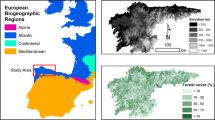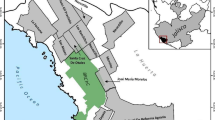Abstract
In this chapter we pose two questions: (i) Does land size relates to forests and ecosystem service (ES) provision concentration? (ii) Do these spatial concentration patterns relate to expressions of vulnerability such as poverty, low human development, and natural capital loss at the municipality level? For the entire Chilean Patagonia and neighboring Biobío region, we found strong positive correlations (>0.92) between land holding size, native forest, and ES provision (as measured by the Ecosystem Service Provision Index). At the municipality level (n = 147), spatial cluster analysis identified five groups. Group 1 comprised 12 municipalities with high Gini coefficients (high inequality) for land size, native forest area, ES provision, and income, high poverty rates, low levels of human development, medium level of rural and indigenous population, high deforestation and afforestation rates, and high ES loss rates. In the other extreme, group 3 comprised 13 municipalities characterized by the coincidence of low Gini coefficients for land size, native forest area, ES provision, and income, lower poverty rates, higher levels of human development, higher levels of rural population, lower deforestation and low afforestation rates, and low ES loss rates. The results corroborate (i) a trilogy of inequalities, where larger landholders concentrate on land, native forests, and ES provision and (ii) a “trap”-like pattern in some municipalities, where inequalities are linked to poverty and natural capital loss, which is more prevalent in municipalities with a medium proportion of indigenous population. The results corroborate the great inequalities that prevail in the Chilean Patagonia, which demand a shift in land, rural development, and natural resources policies. Any conservation or management instrument based on ES provision must consider this context, with a view to avoiding further inequalities.
Access this chapter
Tax calculation will be finalised at checkout
Purchases are for personal use only
Similar content being viewed by others
References
Agostini CA, Brown PH (2007) Desigualdad Geográfica en Chile. Revista de Análisis Económicos 21:3–33
Agostini CA, Brown PH, Góngora DP (2008) Distribución Espacial de la Pobreza en Chile. Estudios Económicos 35:79–110
Alix-Garcia J, Wolff H (2014) Payment for ecosystem services from forests. Ann Rev Resour Econ 6:361–380. https://doi.org/10.1146/annurev-resource-100913-2524.
Arriagada RA, Ferraro PJ, Sills EO, Pattanayak SK, Cordero-sancho S (2012) Do payments for environmental services affect Forest cover? A farm-level evaluation from Costa Rica. Land Econ 88:382–399
Barraclough S (1999) ‘Land Reform in Developing Countries’. UNRISD Discussion Paper 101.Geneva: United Nations Research Institute for Social Development.
Bengoa J (2007) Historia de un conflicto: los mapuches y el estado nacional durante el siglo XX. 242 pp.
Benjaminsen TA, Bryceson I (2012) Conservation, green/blue grabbing and accumulation by dispossession in Tanzania. J Peasant Stud 39:335–355. https://doi.org/10.1080/03066150.2012.667405
Benra F, Nahuelhual L (2019) A trilogy of inequalities: land ownership, forest cover and ecosystem services distribution. Land Use Policy 82:247–257. https://doi.org/10.1016/j.landusepol.2018.12.020
Boonstra W, Boer F (2014) The historical dynamics of social-ecological traps. Ambio 43:260–274
Bopp C, Engler A, Jara-Rojas R, Arriagada R (2020) Are forest plantation subsidies affecting land use change and off-farm income? A farm-level analysis of Chilean small forest landowners. Land Use Policy 91. https://doi.org/10.1016/j.landusepol.2019.104308.
Byerlee D, Deininger K (2013) The rise of large farms in land-abundant countries: do they have a future? L Tenure Reform Asia Africa:333–353. https://doi.org/10.1057/9781137343819_14.
Chonchol J (2003) La Reforma Agraria en América Latina. Proceso Agrar en Boliv y América Lat:205–221
CIREN-CORFO (1999) Digital cartography of rural properties. https://www.ciren.cl/tipo/propiedades/
Clarke D (1975) Land inequality and income distribution in Rhodesia. Afr Stud Rev 18(1):1–7. https://doi.org/10.2307/523705
CONAF (1998). Cadaster and evaluation of native vegetation resources of Chile. http://sit.conaf.cl/
CONAF (2013). Cadaster and evaluation of native vegetation resources of Chile. http://sit.conaf.cl/
Coomes OT, Takasaki Y, Rhemtulla JM (2016) Forests as landscapes of social inequality. Ecol Soc 21:1–20. https://doi.org/10.5751/ES-08684-210320
Davis-Hamel A (2012) Successful neoliberalism?: state policy, poverty, and income inequality in Chile. Int Soc Sci Rev 87:79–101
FAO (2006) Hacia una política pertinente para el desarrollo integral de los pueblos indígneas. 112 pp. Available on http://www.fao.org/3/i3001s/i3001s.pdf
Frankema E (2010) The colonial roots of land inequality: geography, factor endowments, or institutions? Econ Hist Rev 63:418–451. https://doi.org/10.1111/j.1468-0289.2009.00479.x
Gini C (1909) Il diverso accrescimento delle classi sociali e la concentrazione della ricchezza. G degli Econ 38:27–83
Griffin K, Khan AR, Ickowitz AMY et al (2002) Poverty Distrib Land 2:279–330
He J, Sikor T (2015) Notions of justice in payments for ecosystem services: insights from China’s Sloping Land Conversion Program in Yunnan Province. Land Use Policy 43:207–216. https://doi.org/10.1016/j.landusepol.2014.11.011
Hojman D (1996) Poverty and inequality in Chile: are democratic politics and neoliberal economics good for you? J Interam Studies World Aff 38:73–96. https://doi.org/10.2307/166361
Holmes G (2014) What is a land grab? Exploring green grabs, conservation, and private protected areas in southern Chile. J Peasant Stud 41:547–567. https://doi.org/10.1080/03066150.2014.919266
INE (2018) Síntesis de resultados CENSO 2017. Available on https://www.censo2017.cl/descargas/home/sintesis-de-resultados-censo2017.pdf
INFOR (2018) Anuario forestal 2018. Available on https://wef.infor.cl/publicaciones/anuario/2018/Anuario2018.pdf.
IPBES (2019) Regional Assessment Report on Biodiversity and Ecosystem Services for the Americas. Chapter 4. Plausible futures of nature, its contributions to people and their good quality of life. Available on https://ipbes.net/sites/default/files/ipbes_global_assessment_chapter_4_unedited_31may.pdf.
Janvry A, Sadoulet E (2001) Income strategies among rural households in Mexico: the role of off-farm activities. World Dev 29(3):467–480. https://doi.org/10.1016/S0305-750X(00)00113-3.
Jayne TS, Yamano T, Weber MT et al (2003) Smallholder income and land distribution in Africa: implications for poverty reduction strategies. Food Policy 28:253–275. https://doi.org/10.1016/S0306-9192(03)00046-0
Kamal S, Grodzinska-Jurczak M, Kaszynska AP (2015) Challenges and opportunities in biodiversity conservation on private land: an institutional perspective from Central Europe and North America. Biodivers Conserv 24:1271–1292. https://doi.org/10.1007/s10531-014-0857-5
Kay C (2002) Chile’s neoliberal agrarian transformation and the peasantry. J Agrar Chang 2:464–501. https://doi.org/10.1111/1471-0366.00043
Kay C (2006) Rural poverty and development strategies in Latin America. J Agrar Chang 6:455–508. https://doi.org/10.1111/j.1471-0366.2006.00132.x.
Kay C (2007) Land, conflict, and violence in Latin America. Peace Rev 19:5–14. https://doi.org/10.1080/10402650601181808
Keswell M, Carter MR (2014) Poverty and land redistribution. J Dev Econ 110:250–261. https://doi.org/10.1016/j.jdeveco.2013.10.003
Labbé D (2017) El lucrativo negocio del acaparamiento de tierras. El Ciudadano. https://www.elciudadano.com/economia/el-lucrativo-negocio-del-acaparamiento-de-tierras/11/10/
Laterra P, Nahuelhual L, Vallejos M et al (2019) Linking inequalities and ecosystem services in Latin America. Ecosyst Serv 36:1–14. https://doi.org/10.1016/j.ecoser.2018.12.001
Leonard B, Parker DP, Anderson TL (2020) Land quality, land rights, and indigenous poverty. J Dev Econ 143:102435. https://doi.org/10.1016/j.jdeveco.2019.102435
Loughrey JJ, Donnellan T (2017) Inequality and Concentration in Farmland Size: A Regional Analysis for Western Europe. 15th EAAE Congr “Towards Sustain Agri-food Syst Balanc Between Mark Soc 20.
Lowder SK, Skoet J, Raney T (2016) The number, size, and distribution of farms, smallholder farms, and family farms worldwide. World Dev 87:16–29. https://doi.org/10.1016/j.worlddev.2015.10.041
Mahoney J (2000) Path dependence in historical sociology. Theor Soc 29(4):507–548
Martinic M (2006) El poblamiento rural en magallanes durante el siglo xx.: realidad y utopia. Magallania (Punta Arenas), 34(1):5–20
Millennium Ecosystem Assessment (2005) Ecosystems and Human Well-being: Synthesis. Island Press, Washington, DC.
Nahuelhual L, Benra F, Rojas F, Ignacio Díaz G, Carmona A (2016) Mapping social values of ecosystem services: what is behind the map? Ecol Soc 21. https://doi.org/10.5751/ES-08676-210324
Nahuelhual L, Saavedra G, Mellado MA et al (2020) A social-ecological trap perspective to explain the emergence and persistence of illegal fishing in small-scale fisheries. Marit Stud 19:105–117. https://doi.org/10.1007/s40152-019-00154-1
Olper A (2007) Land inequality, government ideology and agricultural protection. Food Policy 32:67–83. https://doi.org/10.1016/j.foodpol.2006.03.009
OXFAM (2016) Unearthed: land, power and inequality in latin America. Available on https://www-cdn.oxfam.org/s3fs-public/file_attachments/bp-land-power-inequality-latin-america-301116-en.pdf
Paruelo JM, Texeira M, Staiano L et al (2016) An integrative index of Ecosystem Services provision based on remotely sensed data. Ecol Indic 71:145–154. https://doi.org/10.1016/j.ecolind.2016.06.054
Pearce F (2012) The landgrabbers: the new fight over who owns the Earth. Eden Project Books, Boston
Pinto J (2012) El conflicto Estado-Pueblo Mapuche 1900-1960. Universum 1:167–189
PNUD (2000) Desarrollo humano en las comunas de Chile. 102 pp. Available on http://bibliotecadigital.ciren.cl/bitstream/handle/123456789/15748/Desarrollofinal.pdf?sequence=1&isAllowed=y
Potter CA, Wolf SA (2014) Payments for ecosystem services in relation to US and UK agri-environmental policy: disruptive neoliberal innovation or hybrid policy adaptation? Agric Human Values 31:397–408. https://doi.org/10.1007/s10460-014-9518-2
Puyravaud JP (2003) Standardizing the calculation of the annual rate of deforestation. For Ecol Manag 177:593–596. https://doi.org/10.1016/S0378-1127(02)00335-3
Reyes R, Blanco, G, Lagarrigue A, Rojas F (2016) Ley de Bosque Nativo: Desafíos Socioculturales para su Implementación. Instituto Forestal y Universidad Austral de Chile. 82 p.
Rommel J, Anggraini E (2018) Spatially explicit framed field experiments on ecosystem services governance. Ecosyst Serv 34:201–205. https://doi.org/10.1016/j.ecoser.2018.10.002
Rouse JW, Haas RH, Schell JA, Deering, DW (1974) Monitoring vegetation systems in the great plains with erts. In Third earth resources technology satellite- 1 symposium, Greenbelt, NASA SP-351; pp. 301–317
Sasso M (2006) Remate de tierras fiscales en el terriotiro de Magallanes (1903). Magallania 34:157–160. https://doi.org/10.4067/S0718-22442006000100010
Schröter M, Stumpf KH, Loos J, Van Oudenhoven APE, Böhnke-henrichs A, Abson DJ (2017) Refocusing ecosystem services towards sustainability. Ecosyst Serv 25:35–43
Severini S, Tantari A (2015) The distributional impact of agricultural policy tools on Italian farm household incomes. J Policy Model 37:124–135. https://doi.org/10.1016/j.jpolmod.2015.01.004
SII (2016) Digital cartography of rural properties. Available on https://www4.sii.cl/mapasui/internet/#/contenido/index.html.
Sikor T (2013) The justices and injustices of ecosystem services.
Stoms DM, Hargrove WW (2000) Potential NDVI as a baseline for monitoring ecosystem functioning. Int J Remote Sens 21:401–407. https://doi.org/10.1080/014311600210920
Sun T, Zhang H, Wang Y, Meng X, Wang C (2010) The application of environmental Gini coefficient (EGC) in allocating wastewater discharge permit: the case study of watershed total mass control in Tianjin. China Resour Conserv Recycl 54:601–608. https://doi.org/10.1016/j.resconrec.2009.10.017
United Nations (2020). World Social Report 2020. Inequality in a rapidly changing world. 216 p. https://www.unilibrary.org/content/books/9789210043670#chapters
von Bennewitz E (2017) Land tenure in Latin America: from land reforms to counter-movement to neoliberalism. Acta Univ Agric Silvic Mendelianae Brun 65:1793–1798. https://doi.org/10.11118/actaun201765051793
Wang P, Wolf SA (2019) A targeted approach to payments for ecosystem services. Glob Ecol Conserv 17:e00577. https://doi.org/10.1016/j.gecco.2019.e00577
Wegerif MCA, Guereña A (2020) Land inequality trends and drivers. Land 9:1–23. https://doi.org/10.3390/land9040101
Wiener E (2011) La concentración de la propiedad de la tierra en América Latina: una aproximación a la problemática actual. Coalición Internacional para el Acceso a la Tierra:64
Yamauchi F (2016) Rising real wages, mechanization and growing advantage of large farms: evidence from Indonesia. Food Policy 58:62–69. https://doi.org/10.1016/j.foodpol.2015.11.004
Zheng X, Xia T, Yang X, Yuan T, Hu Y (2013) The land Gini coefficient and its application for land use structure analysis in China. PLoS One 8:1–10. https://doi.org/10.1371/journal.pone.0076165
Acknowledgments
This work was sponsored and funded by FONDECYT Grant N° 1190207. The authors wish to thank Felipe Benra, Claudio Agostini, and Pedro Laterra whose comments and data helped improve the chapter.
Author information
Authors and Affiliations
Editor information
Editors and Affiliations
Rights and permissions
Copyright information
© 2021 The Author(s), under exclusive license to Springer Nature Switzerland AG
About this chapter
Cite this chapter
Jullian, C., Nahuelhual, L. (2021). Land Size, Native Forests, and Ecosystem Service Inequalities in the Rural Chilean Patagonia. In: Peri, P.L., Martínez Pastur, G., Nahuelhual, L. (eds) Ecosystem Services in Patagonia. Natural and Social Sciences of Patagonia. Springer, Cham. https://doi.org/10.1007/978-3-030-69166-0_18
Download citation
DOI: https://doi.org/10.1007/978-3-030-69166-0_18
Published:
Publisher Name: Springer, Cham
Print ISBN: 978-3-030-69165-3
Online ISBN: 978-3-030-69166-0
eBook Packages: Biomedical and Life SciencesBiomedical and Life Sciences (R0)




